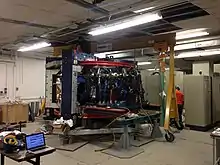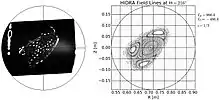Hybrid Illinois Device for Research and Applications
The Hybrid Illinois Device for Research and Applications (HIDRA) is a medium-sized toroidal magnetic fusion device currently being assembled within the Center for Plasma Material Interactions in the Department of Nuclear, Plasma and Radiological Engineering at the University of Illinois at Urbana–Champaign, United States. It is anticipated that HIDRA will have first plasma by mid-September 2015 and start full experimental campaigns by December of that year. HIDRA is the former WEGA classical stellarator that was operated at the Max-Planck Institut für Plasmaphsyik in Greifswald Germany from 2001 to 2013.
| Hybrid Illinois Device for Research and Applications | |
|---|---|
 The completed HIDRA device at the University of Illinois Urbana–Champaign. (Photo: Daniel Andruczyk) | |
| Device type | Stellarator, Tokamak |
| Location | Urbana, Illinois, US |
| Affiliation | University of Illinois at Urbana–Champaign |
| Technical specifications | |
| Major radius | 0.72 m (2 ft 4 in) |
| Minor radius | 0.19 m (7.5 in) |
| Magnetic field | < 0.5 T (5,000 G) |
| Heating power | 26 kW (2.45 GHz magnetron, ohmic heating) |
| History | |
| Year(s) of operation |
|

A unique aspect of HIDRA is that it can not only operate as a stellarator but also as a tokamak, hence the hybrid designation. In fact it should be possible to operate the two modes simultaneously. It is planned to operate up to 30 minutes of continuous plasma, with up to 60 minutes in the future and will concentrate on understanding the complex relationship between the plasma and materials inside the vacuum vessel of a fusion device
History
HIDRA is probably the most well traveled fusion devices in the world. From its beginnings in France it has operated in 3 countries and 4 cities. The research goals of the device have dramatically changed over the years from doing wave heating studies, to being a testbed for one of the world's most sophisticated fusion devices and now to studying the way plasmas interact with the inside wall and materials of fusion devices. In fact it will be the first toroidal fusion-relevant device that will be dedicated to the study of plasma wall (PWI) and plasma material interactions (PMI).
Centre d’Etudes Nucléaires (1972–1982)
HIDRA, in fact, started off as a different machine at the Centre d’Etudes Nucléaires in Grenoble, France in 1972. Back then it was called WEGA with construction of the device from 1972 to 1975. WEGA was a joint project between CEA Grenoble and the Max-Planck-Institut für Plasmaphysik in Germany to study RF heating and lower hybrid heating. There were three vacuum vessel that were built, two tokamak and stellarator. WEGA primarily operated as a tokamak from 1975 to 1982 despite plans to install the stellarator vessel in 1976 (repairs were needed on the helical coil insulation). Electron and ion temperatures achieved were, Te = 600 – 900 eV and, Ti = 150 – 250 eV. Densities of ne = 1.6×1019 m−3 with a plasma current of IP = 45 – 60 kA and heating power, Pohm = 100 – 130 kW and, PRF = 100 kW. Typical pulse duration was, Δt = 5 – 15 ms and an energy confinement time, τE = 3 – 5 ms.
Institut für Plasmaforschung (1982–2000)

In 1982 WEGA moved from Grenoble to the University of Stuttgart in Germany. Unfortunately in Stuttgart it seems that WEGA was not used much. There is not a lot of information from this time and it is very difficult to see what results came out of this 18-year time period. The issues seem to be a lack of enough heating power and cooling. However, IPF did have the stellarator vacuum vessel installed and some of the first magnetic flux surface measurements were performed.
Max-Planck-Institut für Plasmaphysik (2001–2013)
From 2000 to 2001 WEGA moved from Stuttgart to Greifswald. At this stage a new institute had been built in the former East German city to stimulate economic, scientific and educational growth in the region. MPIPP Greifswald was designated to house the brand new modular stellarator W7-X. While W7-X was being built WEGA was brought in to be the machine where much of the diagnostic, heating and control work for W7-X would be tested and perfected. It also provided a valuable tool in the training and teaching of future generations of fusion and plasma scientists and engineers. In fact, though the name was the same the acronym for WEGA changed to "Wendelstein Experiment in Greifswald für Ausbildung" the Wendelstein experiment in Greifswald for Training.
WEGA's magnetic coil systems were run via transformer and rectifier sets that allowed steady state operations. This made WEGA unique among the smaller toroidal fusion devices that normally are pulsed, and only the larger devices such as LHD and W7-X have that kind of steady state capability. Some of the achievements on WEGA include the development of an OXB heating scheme that allows ECRH heating above the cut off density for the electrons in the plasma. This allowed densities almost 100 times higher to be achieved. The W7-X control system was tested on WEGA showing the real time capability of measuring plasma parameters and control of the machine. It was demonstrated, that despite being a stellarator, a plasma current could be driven via microwave heating of the plasma.
In 2013 the last experiments were performed and WEGA was slowly decommissioned as operations for W7-X started to ramp up. WEGA was either going to be scrapped or if a suitable research group was found would be donated.
Center for Plasma Material Interactions (2014–present)

With W7-X operations starting in 2014, the space occupied by WEGA and its power systems was taking up much needed real-estate for the Thompson Scattering system and a cryogenic pellet injection system. During the 2013 SOFE conference, Daniel Andruczyk, a former Post-Doc on WEGA, met with some former colleagues and it was suggested that the University of Illinois could potentially take WEGA to the USA. After a year of negotiating between the director of the Center for Plasma Material Interactions, David Ruzic, the University and IPP, the funds were secured to make it happen. Andruczyk was brought on to lead the project of dismantling and shipping WEGA to the Urbana-Champaign Campus in Illinois. Upon arrival the Machine was renamed the Hybrid Illinois Device for Research and Applications. The Hybrid part being that it still has the tokamak capabilities, not only the stellarator ones.
It took nearly 8 weeks over the autumn of 2014 of dismantling the device in Germany and was packed and shipped by Rhenus to the US in October. By early 4 November shipping containers worth of fusion device arrived by flat bed-truck to the University of Illinois at the Center for Plasma Material Interactions. Aside from lab personnel, the universities Facilities and services division were heavily involved in helping to off load, move in and assemble much of the larger, heavier components. Construction began in earnest with the transformers and rectifiers for the helical and toroidal magnetic coils moving in first. Once these were established then the base was brought in and the yokes, center-stack, half-tori and vertical field coils all installed over the next ten days.
From there it took another 18 months of getting everything else assembled and hooked up. The 20 kV transformer needed for running the coils was made by Cooper electronics and the switching mechanism that to switch it all on was supplied by G&W. Quad-Plus was brought in to commission the rectifiers which allows the field shaping of the device. In this time water cooling tanks were brought in and installed and the universities pipe fitters built the cooling system for the machine and installed the water pump. The control system was written by senior undergrad and grad students and allows the machine to be controlled from one computer via a LabView program. This also sends out the trigger signals that are needed to fire the various data acquisition and diagnostic systems.
Current Status
In April 2016, HIDRA had its first plasma, a simple glow plasma discharge, during the Nuclear, Plasma and Radiological Engineering Departments Open house. With nearly 100 dignitaries and guests including the head of department and Dean of Engineering the HIDRA team was able to demonstrate that all the working components of the device we installed and running and that operations were able to begin.

The first set of data was the characterization of the magnetic flux lines on the machine. This used an in-house electron beam and fluorescing rod method, which was originally developed on WEGA for W7-X, to see what the magnetic field shape, and thus plasma shape, would look like. The beam would be scanned across the minor radius of the vacuum vessel and the rod swept through the vessel. Anywhere an electron beam hit the rod it would light up. a sensitive astronomical camera was used to image the flux surfaces and compare them to a ray-tracing code to see the validity of the plasma and any error fields present. Some gas could also be bled in to visually see the electron beams themselves.
Magnetron Plasmas
